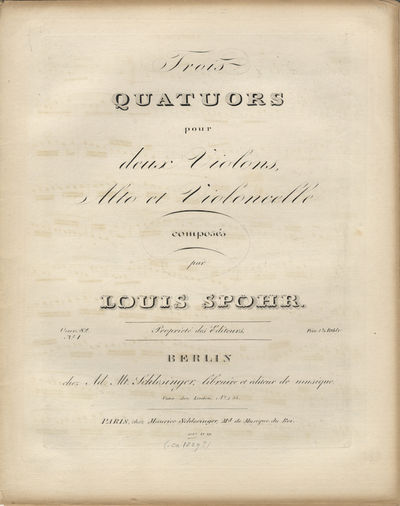1829 · Berlin
by SPOHR, Louis 1784-1859
Berlin: Ad. Mt. Schlesinger [PNs 1547, 1548], 1829. Folio. Disbound. No. 1: Violino 1o.: [1] (title), 2-13, [i] (blank) pp.; Violino 2o.: [i] (blank), 2-10 pp.; Viola: [1] (blank), 2-10 pp.; Violoncello: 6 pp. No. 2: Violino 2o.: 1f. (title), [i] (blank), 4-13, [i] (blank) pp.; Violino 2o.: 7, [i] (blank) pp.; Viola: 7, [i] (blank) pp.; Violoncello: 7, [i] (blank) pp. Engraved. Publisher's handstamp to lower left corner of title of no. 2 only.
Measure numbers added in pencil in a modern hand throughout.
Edges browned and slightly frayed; impression occasionally light; some illegible marks redrawn in pencil; Violino 2o. part of no. 2 dampstained at lower inner corner and closely trimmed at outer margin, with slight loss to music. First Edition of Spohr's 23rd and 24th quartets, in E major and G major, most probably a compilation of various issues (Violino 2o. part of No. 2 possibly an earlier issue). Göthel p. 138. WorldCat (5 complete copies (of all three op. 82 quartets) in the U.S., at the Eastman School of Music, Juilliard, Indiana University, Harvard, and the University of Michigan. Copy of no. 2 at the University of Toronto.
"The largest portion of Spohr's chamber music was for strings alone, ranging from 19 unsurpassed duos for two violins to four masterly, and largely unemulated, double string quartets. These, together with the 36 string quartets (and several other works for the same combination), seven string quintets and the String Sextet of 1848, display a number of common features. Spohr's own mastery of the violin is evident in all of them, and their technical difficulties, together with the particular style of performance necessary to secure their full effect, may partly explain their infrequent performance. The quartets, especially, fall into two distinct categories: solo quartets in the tradition of Rode (often entitled Quatuor brillant), which are essentially violin concertos with string trio accompaniment, and true quartets where the interest is more evenly divided between the instruments." Clive Brown in Grove Music Online. (Inventory #: 25982)
Measure numbers added in pencil in a modern hand throughout.
Edges browned and slightly frayed; impression occasionally light; some illegible marks redrawn in pencil; Violino 2o. part of no. 2 dampstained at lower inner corner and closely trimmed at outer margin, with slight loss to music. First Edition of Spohr's 23rd and 24th quartets, in E major and G major, most probably a compilation of various issues (Violino 2o. part of No. 2 possibly an earlier issue). Göthel p. 138. WorldCat (5 complete copies (of all three op. 82 quartets) in the U.S., at the Eastman School of Music, Juilliard, Indiana University, Harvard, and the University of Michigan. Copy of no. 2 at the University of Toronto.
"The largest portion of Spohr's chamber music was for strings alone, ranging from 19 unsurpassed duos for two violins to four masterly, and largely unemulated, double string quartets. These, together with the 36 string quartets (and several other works for the same combination), seven string quintets and the String Sextet of 1848, display a number of common features. Spohr's own mastery of the violin is evident in all of them, and their technical difficulties, together with the particular style of performance necessary to secure their full effect, may partly explain their infrequent performance. The quartets, especially, fall into two distinct categories: solo quartets in the tradition of Rode (often entitled Quatuor brillant), which are essentially violin concertos with string trio accompaniment, and true quartets where the interest is more evenly divided between the instruments." Clive Brown in Grove Music Online. (Inventory #: 25982)



